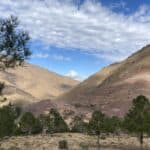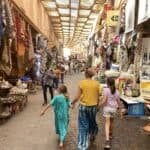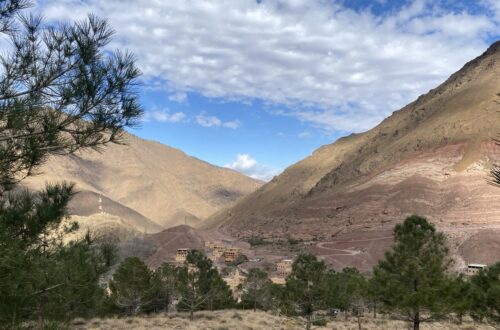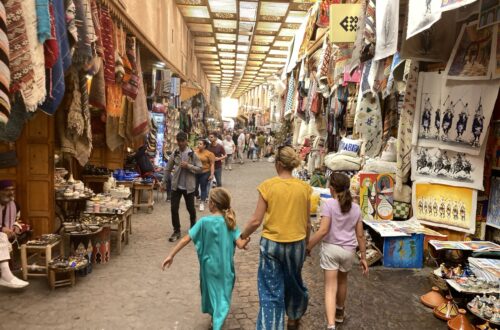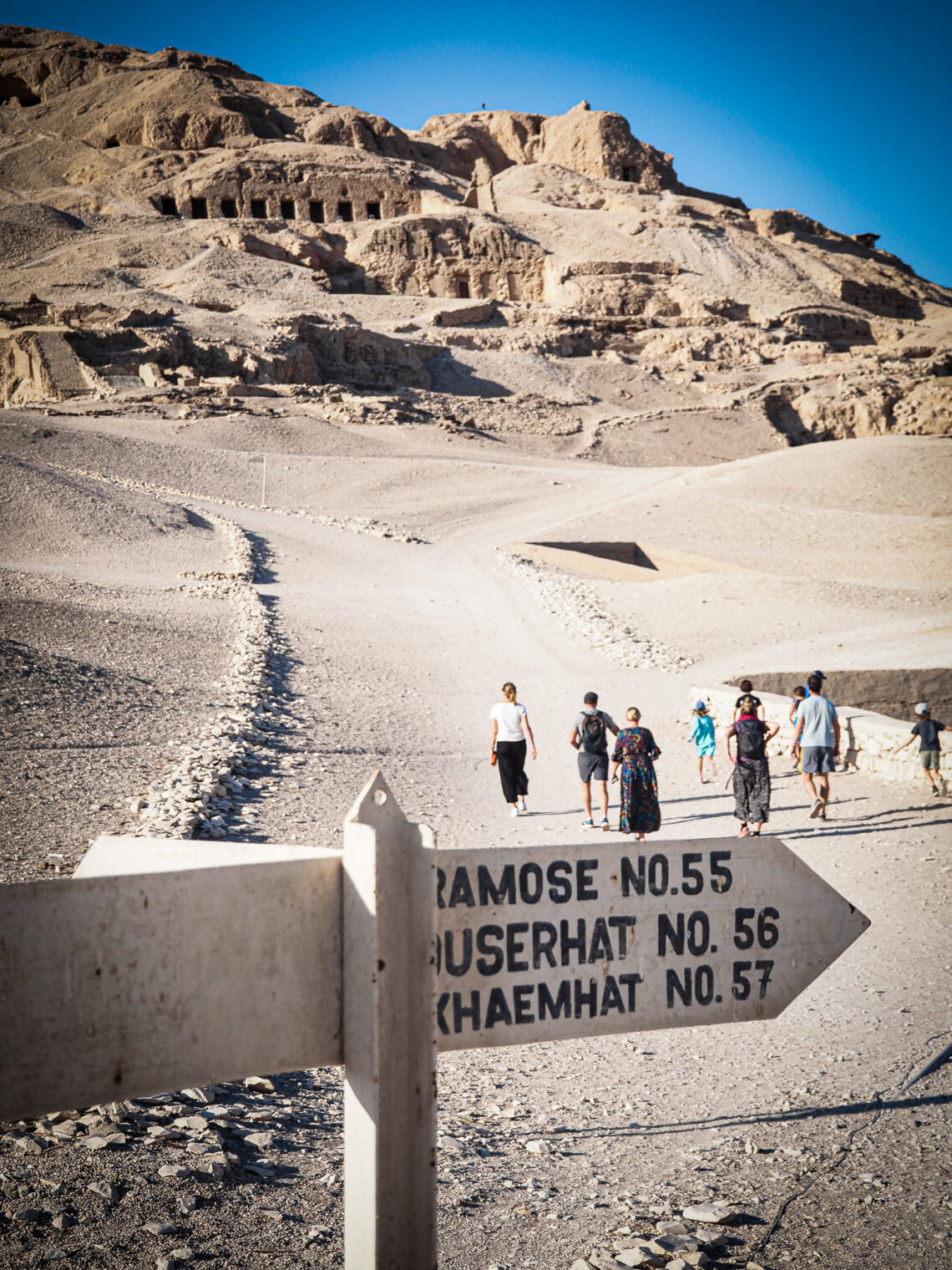
The Valley of the Kings- Plan your Visit 2024
Have you heard of The Valley of the Kings? If not, you must have heard of Tutankhamun! Probably the most famous Egyptian Pharoah.
The Valley of the Kings is one if not the most famous archaeological sites. It is one of the most significant and well-known burial grounds in ancient Egyptian history. The site served as the final resting place for many pharaohs and powerful nobles of the New Kingdom period, which lasted from around 1550 BCE to 1077 BCE.
The Valley of the Kings was chosen as a burial site for its strategic location, hidden within the cliffs of the Valley of the Kings, providing a level of security and privacy for the tombs of the ancient rulers. It’s easy to see how this place could be lost in time and that is exactly what happened. Unlike the earlier pyramids, which were easily identifiable and often subjected to looting, the tombs in the Valley of the Kings were built to be concealed and protected.
The valley contains over 60 known tombs, though not all of them belong to pharaohs. Some are tombs of high-ranking officials and members of the royal family. The most famous tomb in the Valley of the Kings is that of Tutankhamun. Discovered by Howard Carter in 1922, Tutankhamun’s tomb is one of the few to be found mostly intact, containing a vast array of precious artifacts and treasures.
Each tomb is a complex structure with intricate decorations, paintings, and hieroglyphs, showcasing the ancient Egyptians’ beliefs in the afterlife and the divine journey of the deceased pharaoh to the realm of the gods. Each tomb is unique and special in its own way, and this guide is to help you navigate your way around The Valley of the Kings.
Where is the Valley of the Kings?
The Valley of the Kings is located on the west bank of the city of Luxor, a short flight from Cairo. Luxor city is split; the East bank being the main city and the West bank maintaining its old village feel, and more importantly, The Valley of the Kings.
Known as Thebes in ancient times, Luxor boasts a rich heritage that stretches back over 4,000 years. This captivating city was once the glorious capital of the New Kingdom, and remnants of its illustrious past are scattered throughout its modern streets. Today it has become an open-air museum!
How to get to the Valley of the Kings
Take a local ferry across the Nile River from Luxor to the West Bank (costing a few Egyptian pounds). Once on the West Bank, you can grab a taxi to the Valley of the Kings. The ferry ride takes about 10-15 minutes, and the taxi ride from the West Bank takes about 20-25 minutes.
Coming from Cairo? consider taking the Go Bus. Read our blog post here.
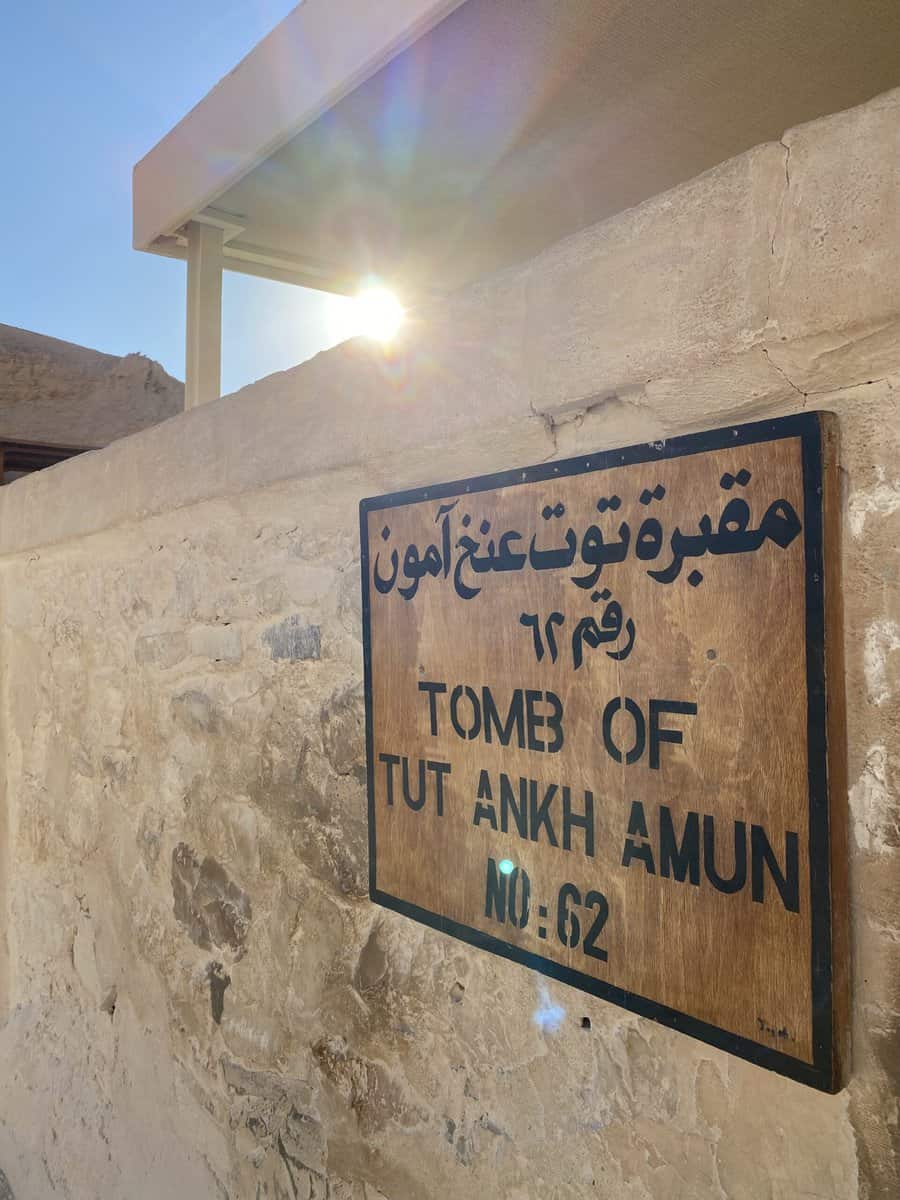
our family Friendly Guide to Luxor
Top tips for visiting the tombs
- Opening hours for the Valley of the Kings are typically from 8:00 AM to 4:00 PM, but it’s always good to check the official website for any updates before your visit.
- The tombs in the Valley of the Kings can become incredibly hot and humid, especially if there’s a lot of people in there. Make sure you dress appropriately in cool, light clothing.
- Visit early in the morning. The Valley of the Kings is one of the most popular tourist attractions in Egypt, so it can get crowded, especially in the afternoon. If you want to avoid the crowds, try to visit early in the morning.
- Bring water and snacks. The Valley of the Kings is a large uncovered area, and you’ll be doing a lot of walking. It’s important to stay hydrated and well-fed, so bring plenty of water and snacks with you.
- Be respectful. The Valley of the Kings is a sacred site, so it’s important to be respectful of the tombs and their contents. Don’t touch anything, and be mindful of your noise level.
- Take your time. There’s no need to rush through your visit to the Valley of the Kings. Take your time, and enjoy the experience.
How much is it to visit the Valley of the Kings
Currently, the Valley of the Kings offers access to eight tombs with the main entrance ticket, allowing visitors to explore three of them. EGP 260 (around USD 13)
Discounts:
- Children aged 6 to 12 years old receive a 50% discount on all entrance fees.
- Children under 5 years old enter for free.
If you wish to visit more than three tombs, you’ll need to purchase an additional ticket.
Out of the over 60 tombs in the Valley of the Kings, only a select few are open to the public at any given time, with the specific tombs chosen for preservation purposes. As of March, 2024, there are 11 tombs open to the public:

Included with General Admission Ticket
You can choose three tombs to visit with your general admission ticket
KV1 – Ramesses VII: This tomb of the last pharaoh of the 20th Dynasty.
KV2 – Ramesses IV: This tomb is known for its well-preserved ceilings and colourful scenes depicting the journey of the pharaoh to the afterlife.
KV6 – Ramesses IX: This tomb is relatively small but features interesting scenes from the Book of the Dead.
KV8 – Merenptah: This tomb is the largest tomb open to the public and the son of the famous Ramesses II.
KV11 – Ramesses III: This impressive tomb is known for its large size and well-preserved scenes depicting the pharaoh’s victories in battle.
KV14 – Tausert & Setnakht: This tomb is unique as it was originally built for pharaoh Siptah but was later usurped by Queen Tausert and her son Setnakht.
KV15 – Seti II: This tomb is known for its interesting scenes depicting the offerings made to the gods.
KV16 – Ramesses I: This tomb is the resting place of Ramesses I, the founder of the 19th Dynasty.
KV43 – Thutmose IV: This tomb is dedicated to Pharaoh Thutmose IV and features scenes depicting his coronation and military campaigns.
KV47 – Siptah: This tomb was originally built for Pharaoh Siptah but was later used by some priests of the 21st Dynasty.
Additional Tickets Required
KV9 – Ramesses V & VI: This tomb features the mummies of two pharaohs, Ramesses V and VI. 100EGP
KV17 – Seti I: This magnificent tomb is known for its stunningly well-preserved paintings and intricate details. It’s considered one of the most beautiful tombs in the Valley of the Kings. 1000EGP
KV62 – Tutankhamun (King Tut): This world-famous tomb is the final resting place of Pharaoh Tutankhamun, more commonly known as King Tut. It’s the only tomb discovered almost completely intact, containing a wealth of treasures. 300EGP
KV16– Ramesses I: The founder of the 19th Dynasty of Egypt. He reigned for only a few years, from 1279 to 1213 BC, but his impressive tomb offers historical and artistic insights into this period. EGP 100
Check the official website of the Egyptian Ministry of Tourism and Antiquities (https://egymonuments.gov.eg/) for the latest information if you set on visiting particular tombs before your visit.
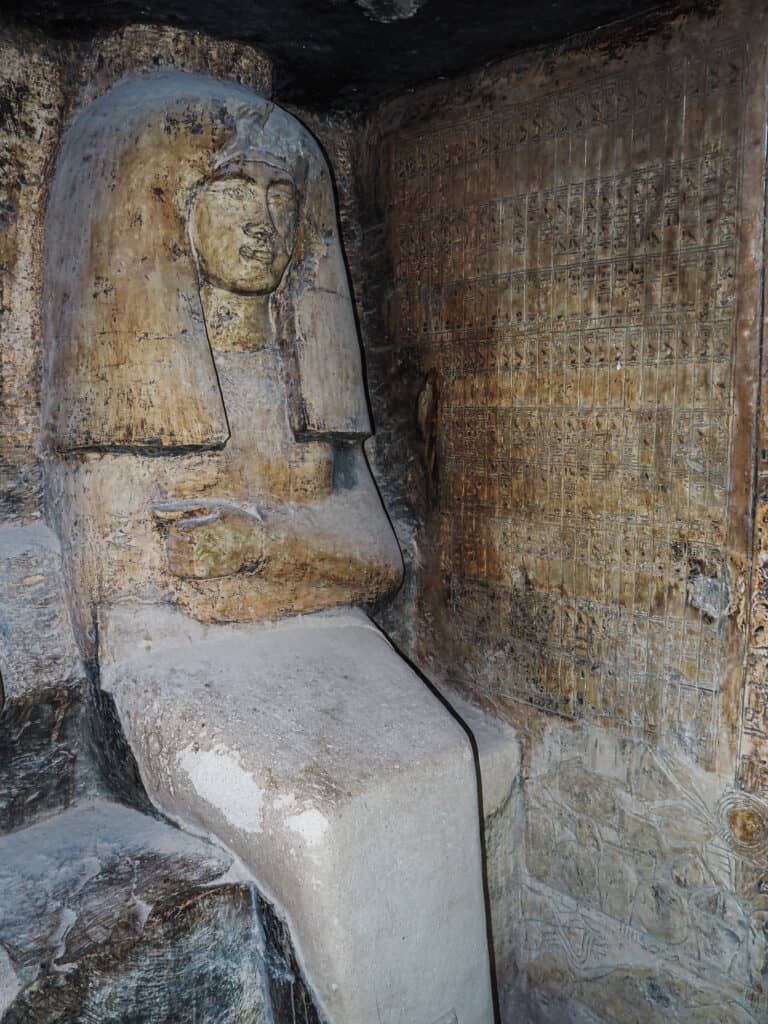
Which tombs to visit- A detailed guide
TOMB OF RAMESSES V AND VI
Requires an extra ticket: 100 EGP
The tomb of Rameses V & VI (KV9) in the Valley of the Kings is a must-see attraction. It offers one of the best and most vivid displays of art in Egypt.
This massive tomb spans over 100 meters and features a beautiful pillared hall leading to the stunning burial chamber. Inside, you’ll find the remains of two big sarcophagi, one of which has been rebuilt, along with artwork depicting the book of Nut, stories about the night sky, stars, and the sun.
The burial chamber’s thousands of hieroglyphs and low lighting create an amazing experience. Many consider this tomb one of their favourites in the valley, second only to that of Seti I.
Historically, not much is known about Rameses V. In his brief four-year reign, he is believed to have faced a civil war, and was buried during Rameses VI’s reign, which is uncommon in ancient Egypt.
Rameses VI reigned for eight years, witnessing the continued decline of Egypt with abandoned turquoise mines in the Sinai and diminishing Egyptian power in the east. The tomb building was completed by Rameses VI, who was also interred there, but unfortunately, the tomb was raided just 20 years after his death.
KV 17 – TOMB OF SETI I
Requires an extra ticket: 1000 EGP
The tomb of Seti I (KV17) in the Valley of the Kings is a must-see (if you are willing to pay). It is regarded as the best tomb in Egypt, offering a vast labyrinth of rooms adorned with incredible artwork.
As the most expensive tomb in the valley, Seti I’s tomb is relatively quiet, and with good timing, you might even have it all to yourself. The paintings inside are exceptionally well-preserved, and the low lighting enhances the experience.
The tomb’s entrance features hieroglyph-covered staircases, leading to the first pillared room decorated with art on a white background, followed by a room covered in stencils, providing insight into the painting techniques of the time. The second staircase leads to the breathtaking golden burial chamber, filled with intricate art. Exploring the tomb thoroughly requires about an hour to fully appreciate its splendour.
Seti I was an esteemed pharaoh known for military achievements during his 12-year reign. He focused on reconquering Egyptian territories and reasserting Egyptian authority over Canaan, Syria, and Nubia, ushering in the final golden age of Egypt, which his son Rameses II continued in his own reign.
It is one of the deepest tombs in the Valley of the Kings.
KV62 Tutankhamun (KV62)
For possibly the most famous pharaoh, you may be a little disappointed with the size of his final resting place. The tomb features impressive wall art, including 12 baboons signifying the midnight hours on one wall and various depictions of Tutankhamun, Ay, and other figures on the remaining walls. However, the number of paintings is fewer compared to other tombs in the Valley of the Kings.
What sets this tomb apart is the presence of Tutankhamun’s mummy. This is the only tomb which contains a mummy. At the bottom of the staircase, visitors can see a glass box containing the head and feet of Tutankhamun’s mummified body, making it a unique sight. If you are not interested in seeing the mummy, you can head to the Howard Carter Museum which has built an exact replica of the tomb.
Tutankhamun himself was a relatively unremarkable pharaoh who ascended to the throne at a young age and died prematurely at the age of 19. It is believed that he suffered from several physical ailments, an idea supported by the canes found in his tomb.
However, what makes him renowned throughout history is the discovery of his tomb by Howard Carter in 1922. The tomb was found almost entirely intact, with all its treasures still preserved, which was a rare occurrence since most tombs had been looted in antiquity. This discovery was considered one of the greatest archaeological finds in history.
It is worth noting that all these treasures (and there are many!) are housed in the Grand Egyptian Museum in Cairo.

KV16 Rameses I
Although it may seem busy because of its smaller size, the tomb can fill up quickly. Many visitors initially attempt to enter Seti I’s tomb and end up here after learning about its lower price tag. The tomb features a plain set of stairs that lead down to a beautifully painted burial chamber, surprising visitors with its fantastic and colourful artwork.
Unlike many other tombs, the paintings in Rameses I’s tomb are set against a light blue background and are in excellent condition. You can admire depictions of the mummification process, snakes, gods, and hieroglyphics, all surrounding a red granite sarcophagus.
Rameses, I served as the vizier (advisor) of Horemheb and became pharaoh in his fifties. His reign was short, lasting only two years, which explains the relatively understated nature of his tomb compared to others in the vicinity. He played a significant role as a transitional pharaoh, stabilizing Egypt after the changes brought about by Akhenaten, before the reigns of his son Seti I and grandson Rameses II, who left a more lasting mark in history.
KV2 – TOMB OF RAMESSES IV
Inside the tomb, you’ll encounter beautiful artwork, with the best-preserved pieces found as you approach the burial chamber. There is a massive sarcophagus, one of the largest in the valley.
The highlight of the tomb is the impressive burial chamber, which was quickly converted from a pillared hall upon Rameses IV’s death. The ceiling has artwork depicting the goddess Nut and the night sky, adding to its beauty.
In addition to the Egyptian art, you can also observe “Coptic graffiti” left by Roman and ancient Greek visitors at the start of the tomb.
Rameses IV became pharaoh at a young age after the assassination of his father, Rameses III. He was involved in significant building projects during his reign, but unfortunately, his time as pharaoh was short, lasting only six years.
KV11 – TOMB OF RAMESSES III
Rameses III’s tomb is known for its beautiful artwork, with some unique features, such as a blind harpist in one of the side chambers. The builders had to make a sudden change in direction inside the tomb to avoid digging into a neighbouring tomb, adding an interesting twist to the walkway.
The tomb culminates in a large pillared hall adorned with paintings. As it is located beyond many of the major attractions in the valley, this tomb tends to have fewer visitors, making it a quieter experience.
Rameses III was known for his grandeur, and his 31-year reign was marked by constant wars and turmoil in the Mediterranean, affecting Egypt’s empire’s frontiers. His reign ended with an alleged assassination by his wife Tiye, who wanted her son to become pharaoh instead of Rameses IV, the chosen successor.
Full of fascinating stories, KV11 was originally built for Rameses III’s father, Setnakht. However, Rameses III decided to use it for himself, relocating Setnakht’s burial to KV14, the tomb of Tausert.
KV11 is among the largest tombs in the Valley of the Kings, featuring long passageways with intricate artwork protected by glass, allowing visitors to explore the burial chamber filled with intriguing details.
KV 14 – TOMB OF TAUSERT AND SETNAKHT
The tomb of Tausert and Setnakht (KV14) in the Valley of the Kings is an intriguing tomb to visit, known for its stencils that show how the art was made and the presence of a sarcophagus.
Originally built for Tausert, one of Seti II’s queens, the tomb’s construction continued as she became co-regent when her son Siptah was a young pharaoh before eventually succeeding him as ruler. The tomb was later altered and extended to accommodate a larger sarcophagus, reflecting her new status as the ruler of Egypt.
The tomb features several corridors and two large columned chambers. Although the initial art appears degraded, it improves as you progress, with some vivid artwork in the first burial chamber before reaching the spacious second burial chamber containing the sarcophagus.
The story of the tomb becomes even more interesting when Rameses III became pharaoh. Originally built for Setnakht, who succeeded Tausert, Rameses III decided to place Setnakht in Tausert’s tomb and keep KV11 (Setnakht’s original tomb) for himself. Some believe this decision was due to the builders of KV11 having to halt construction when they nearly dug into a neighbouring tomb.
Comprising two tombs, the first belonging to Queen Tausert and later enlarged by King Setnakht, KV14 offers a glimpse into the history of both monarchs. As one of the most interesting tombs at this end of the valley, it shows not only the art and style of the tomb but also the unique historical context surrounding its occupants.
KV6 – TOMB OF RAMESSES IX
If you have time, you can visit the tomb of Rameses IX (KV6) in the Valley of the Kings. The tomb is located in an area with seven other tombs within 100 meters of each other.
While the tomb is still impressive on a global scale, it is considered one of the less favoured ones in the valley. The artwork inside, including the ceiling, is striking, but much of it has degraded over the years. Some panels of glass are present midway up the tomb.
Rameses IX had a lengthy reign of 18 years, but it was a troubled time for Egypt, marked by the weakening of the pharaoh’s power and several Libyan incursions. His focus on lower Egypt allowed the high priest of Amon, Amenhotep, to exercise significant control in Thebes and upper Egypt.
Overall, the tomb of Rameses IX offers some decent art, but it is more degraded compared to other tombs in the Valley of the Kings.
KV 15 – TOMB OF SETI II
Seti II’s tomb (KV15) in the Valley of the Kings is a site for those of you who love all things ancient Egypt only, it’s pretty underwhelming compared to other tombs in the valley. However, it still contains interesting features such as stencils and beautiful artwork above a decapitated sarcophagus.
Situated furthest from the entrance in the main part of the Valley of the Kings, Seti II’s tomb is relatively small and modest in terms of its paintings. Despite this, you can still admire some beautiful depictions, including vultures in the main corridor, red stencils of unfinished hieroglyphs, and a stunning painting of the goddess Nut above the sarcophagus in the burial chamber.
The unique feature of this tomb is the beheaded sarcophagus, which is quite unusual compared to other tombs in the Valley of the Kings.
Seti II’s reign was marked by controversy, evidence suggests that Amenmesse, possibly his half-brother, seized the throne during his six-year tenure as pharaoh. The tomb contains inscriptions that were engraved, erased, and then re-engraved, indicating disruptions during his rule.
The tomb showcases a passageway adorned with low reliefs displaying the Litany of Ra, but it offers lower passageways with less artwork on the walls compared to other tombs. Descending through a beautifully decorated room of pillars leads to the burial chamber, where visitors can view the unique sarcophagus of Seti II. While not as grand as some other tombs in the valley, it provides an intriguing glimpse into the history and artistry of ancient Egypt.
KV8 – TOMB OF MERENPTAH
The tomb of Merenptah (KV8) in the Valley of the Kings is recommended for a visit. While it may not be one of the best in the valley, it offers a unique and quieter experience than the early section of the site.
The tomb is spacious and features a long corridor leading to two chambers. The first chamber contains the lid of a sarcophagus with a mirror below, displaying a carving of the goddess Nut. Another corridor leads to the burial chamber, which still houses the massive base of the sarcophagus and an impressive lid to the side. Although much of the artwork on the walls has deteriorated, the burial chamber still has a cathedral-like feel to it.
Merenptah, the thirteenth son of Rameses II, became pharaoh after a lengthy wait, but he reigned for ten years, demonstrating his experience gained through previous positions such as overseer of the army, Crown Prince, and Prince Regent during the final years of Rameses II’s life.
Despite the challenges and revolts he faced on Egypt’s frontiers, Merenptah successfully repelled them. He was the last stable ruler in the 19th dynasty, as his successors saw short reigns and disruption.
While lacking some of the intricate artwork seen in other tombs, Merenptah’s tomb offers an interesting walk through its long passageways and images of the king with the god Ra-Horakhty on the walls. The tomb’s burial chamber holds historical significance, as Merenptah’s mummy is now housed in the Egyptian Museum.
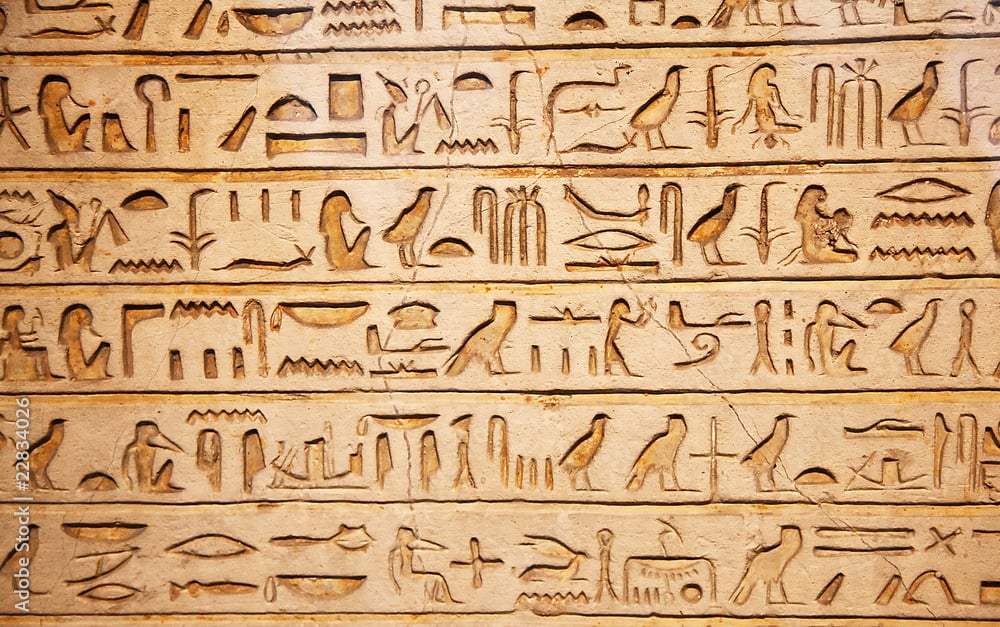
ADDITIONAL RECOMMENDATIONS
If open, these two tombs are highly recommended to visit if accessible:
KV 57 – TOMB OF HOREMHEB
One of the deepest tombs in the Valley of the Kings, Horemheb’s tomb contains undecorated corridors leading to a burial chamber adorned with vibrant images of the king alongside deities.
KV 34 – TOMB OF TUTHMOSIS III
Regarded as one of the most spectacular tombs in the Valley of the Kings, this tomb’s ceiling is decorated with yellow stars on a dark blue background, and the walls feature scenes of the Amduat, or “That Which is in the Underworld.”
THE TOMBS OF RAMESSES VII (KV1) AND SIPTAH (KV47)
These two tombs were not visited during this particular account. According to available information, both are regarded as relatively modest in comparison to other tombs. Siptah’s tomb has undecorated passageways, and its burial chamber is unfinished. Ramesses VII’s tomb is notably smaller, featuring one short passageway and a burial chamber.
WHICH TOMBS DO WE RECOMMEND?
Of the eight tombs that are included on the main entrance ticket, we would recommend a visit to
- K11 (Ramesses III)
- KV 14 (Tausert and Seknakht).
- Ramesses IX (KV6).
It is totally worth it to spend 100 EGP to visit the tombs of Ramesses V and VI.
If you want to see the mummy of Tutankhamun then 300EGP is worth it but honestly the tomb is very small and the mummies in the Grand Egyptian Museum are in much better condition.
Are three tombs enough?
Absolutely, the tombs can become a little repetitive, they can be super busy, hot and crowded. Three tombs are enough for most visitors. If you want more, consider heading to the Valley of the Queens or the Valley of the Nobles.

Meet the author
Lisa is the founder of Boston Tribe Travels. She has lived and travelled abroad for the last 15 years, visited more than 30 countries and has done most of that with her husband and two children. As a full time travel family, they like to travel slow, worldschool and seek new adventures. From living in Borneo for 5 years to backpacking South America, Lisa shares a wealth of travel experience to empower more families to travel and learn together.





